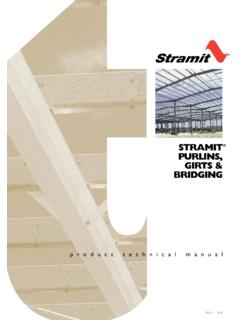Transcription of Rigging: Guide Part 2 1995 - riggingtraining.com.au
1 part two Basic rigging 109. Chapter 11 Steel erection Introduction The use of structural steel in the construction of multi-storey buildings was very common until the development of concrete reinforced design. Over recent years, however, structural steel design has started to make a comeback in multi-storey work. Portal frame construction is also widely used for low rise factories and warehouses. Structural steel is used extensively in the construction of powers stations, smelters, refineries, bridges, transmission towers, communications towers and other industrial projects.
2 Certification Those engaged in (or directly supervising) steel erection must hold a Basic rigging certificate or equivalent old certificate. Where steel erection involves multiple crane lifting operations or the use of load equalising gear, the Intermediate rigging certificate (or equivalent old certificate) is required. The erection of permanently guyed structures (such as some communications towers) requires the Advanced rigging certificate (or equivalent old certificate). Trainee riggers who can produce a properly maintained logbook which details at least 25 working days of practical rigging experience in the erection of steel structures greater than 4m in height, are entitled to a major reduction in the amount of practical skills assessment needed to qualify for the Basic rigging certificate.
3 Riggers must be familiar with the common erection methods and be able to recognise the typical hazards associated with this type of work. They must be able to read and understand construction drawings and specifications. They must also have the skills necessary to use the tools and equipment needed to erect steel and they must be able to work safely and confidently at heights. Steel erection Structural steel is basically a skeleton, designed to support a building. The first section must be fully plumbed and wind braced to ensure stability for the rest of framework. As erection progresses, the wind bracing must be fitted.
4 In some A-Frame' or Saw tooth' type buildings, which are long and narrow, the building may have to be guyed for support until each wind brace bay is erected. Columns should be guyed to prevent the holding down bolts from pulling out causing the column to collapse. The concrete in the plinth that the column stands on is usually green. Guys that are left on overnight must be FSWR guys. Fibre ropes shrink when they are wet and stretch when they are dry, and are therefore dangerous to use as guys. The foreman or a competent person should ensure that every column base is level using a theodolite or a dumpy level before starting to erect the columns.
5 Bush jobs could use a spirit level. There should be a packer (elevation pad) underneath every column. If the column bases are not level the steel will not be plumb. It can be very difficult to wedge up steel especially if the steel is heavy. Steel packers approximately the same height as the elevation pad should be placed adjacent to each holding down bolt. Use steel wedges if necessary for plumbing purposes. 111. The mass (weight) of any steel must be known for lifting into place. When ordering cranes to raise columns, a second crane may be required to float' in the base.
6 When raising a column with two cranes at the column head each crane should be capable of lifting the total weight of the column. If this is not possible, equalising gear must be used. To ensure that columns hang vertically they should be slung as near to the top as possible. When lifting columns with a reeved sling ensure that the sling is wrapped around twice then nipped (round turn). As the sling is wrapped around, incline the sling toward the nip, stopping the sling from slipping when the column becomes vertical. The column must be packed to prevent the sling from being damaged by the sharp edges of the column.
7 The packing has to be tied or secured to prevent it from dropping out when the slings slacken as the column is landed. Heavy columns which are erected and spliced in the air must have scaffold brackets or bearers fitted before erecting the column. 112. Beams and girders The mass (weight) of each beam or girder must be known. Make sure that the crane is capable of lifting the beam to the required height. That is, check the crane drift before lifting. Ensure that the correct size slings are used and see that the beam is adequately packed. Ensure that the packing will not drop out when the weight is released from the slings.
8 Lift the beam level unless it is intended to be canted. Take special care with warren or lattice beams, because the sharp edges of gussets can easily cut through slings. Attach tag lines to each end of the beam to control it during the lift, even when setting steel on multi- storey jobs. Short hand lines at either end will allow the top hands to control the beam more easily. If a crane has to be boomed out to land a beam the crane must be capable of lifting the beam at that radius. Booming out with a load in the air is dangerous especially if the load is heavy. Lift the beam as close as possible to its final position.
9 The end of a beam nearest to rigid steel must be fixed first, then if necessary adjust the steel at the other end. The old saying get the first podger hole and let your mate worry' is not good practice. Field bolted beams must be bolted on diagonally opposite sides to prevent the beam from rolling. Position the beam onto the podger when lowering so that if the crane over runs slightly, the top hands have control. It is dangerous to set the podgers while raising the beam. If the crane operator over runs slightly the sling could be overloaded and broken. When setting steel beams into the web of other beams make sure that the crane operator inches' the load very slowly allowing reaction time for the crane operator to stop.
10 Do not use shifting spanners for tightening bolts when working aloft. Use proper set or ring spanners (preferably the podger type). Do not work on wet or wet painted steel. Do not set steel in gale force winds. 113. Tapered drifts should be held by hand when being driven in to stop them being driven right through. Hammers should have a restraining lanyard to stop them from being dropped from aloft. Spliced columns have to be aligned directly above one another when being positioned. When landing a beam experienced riggers will push a drifting beam across and drop their podgers in.







